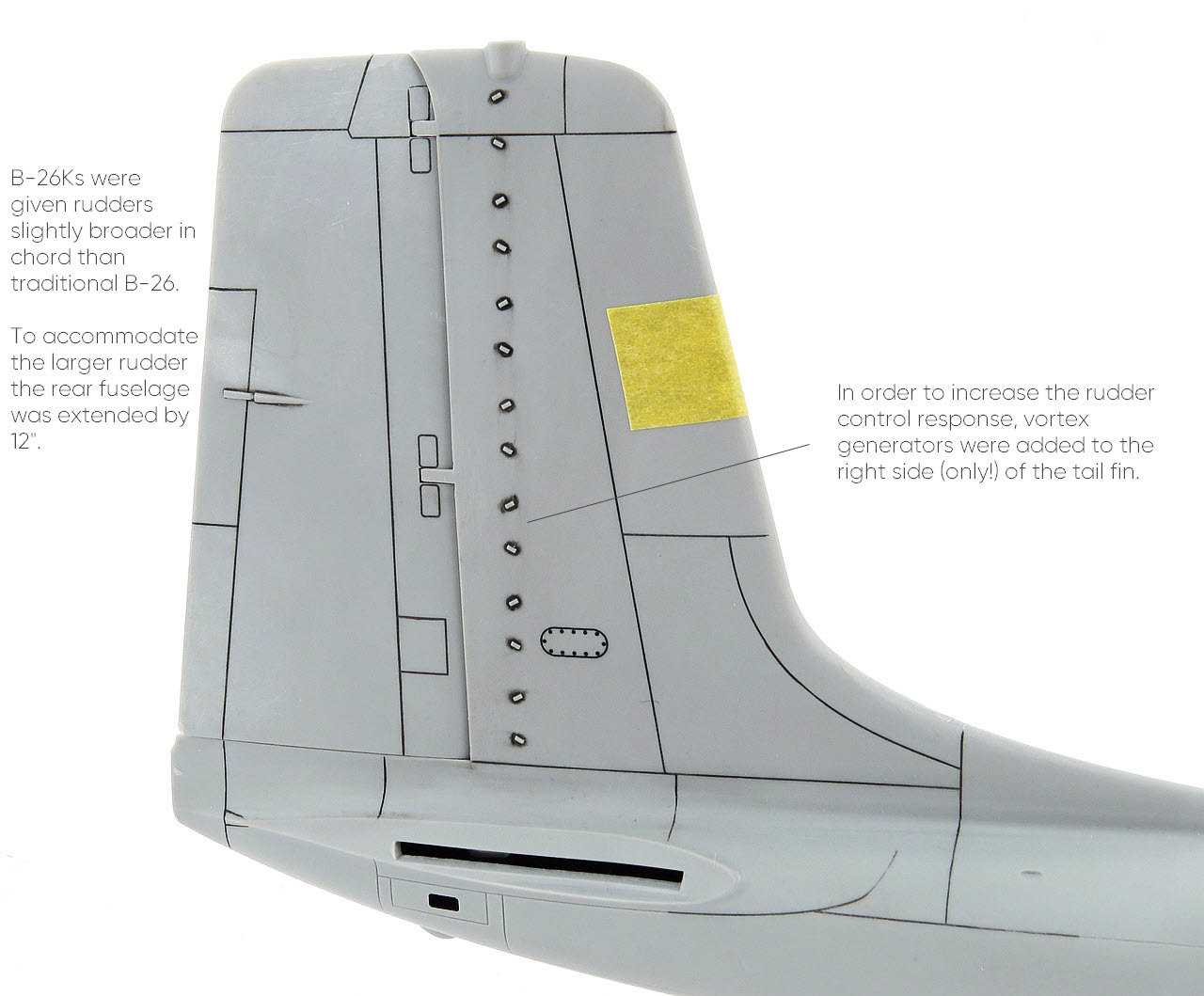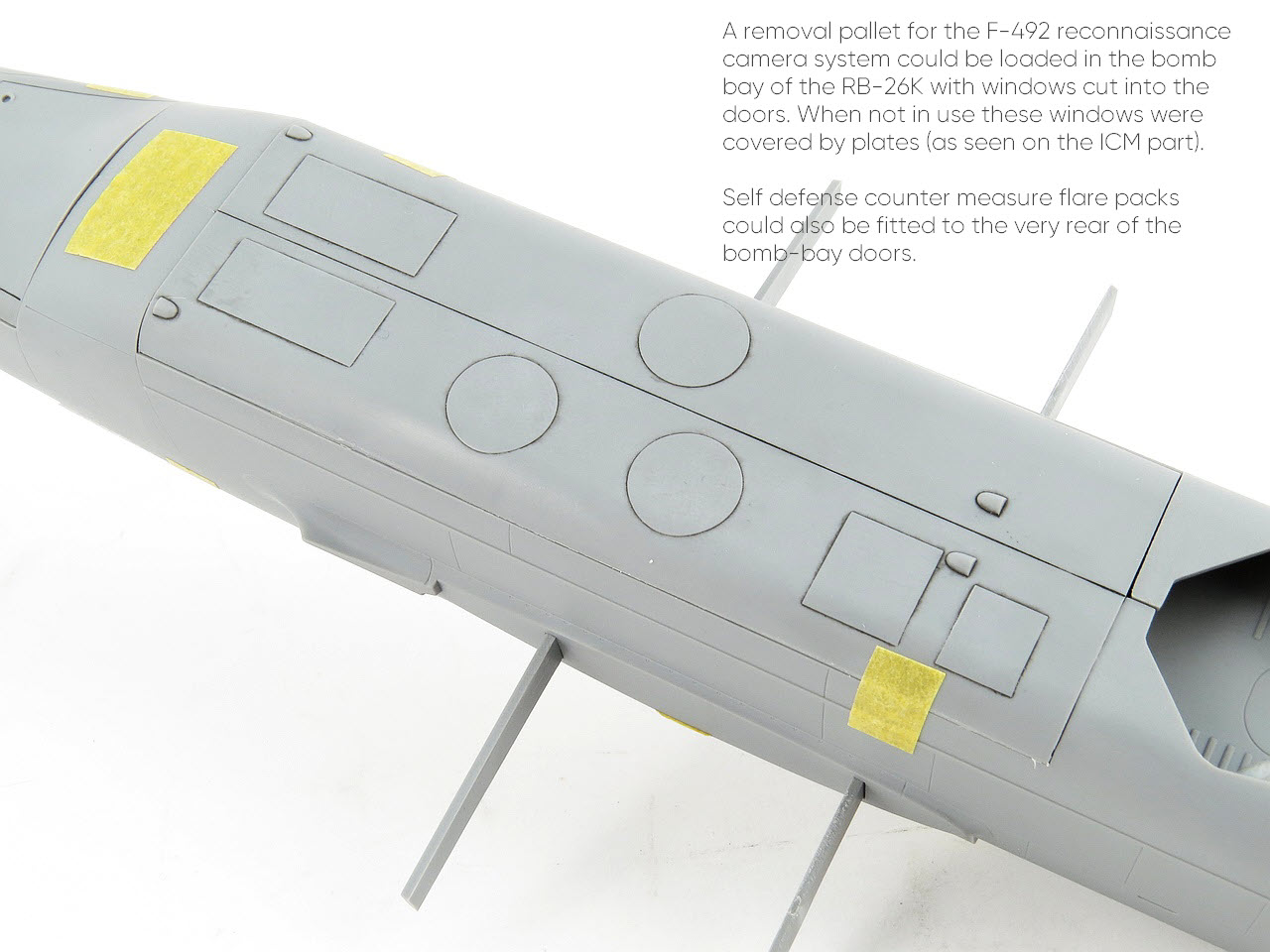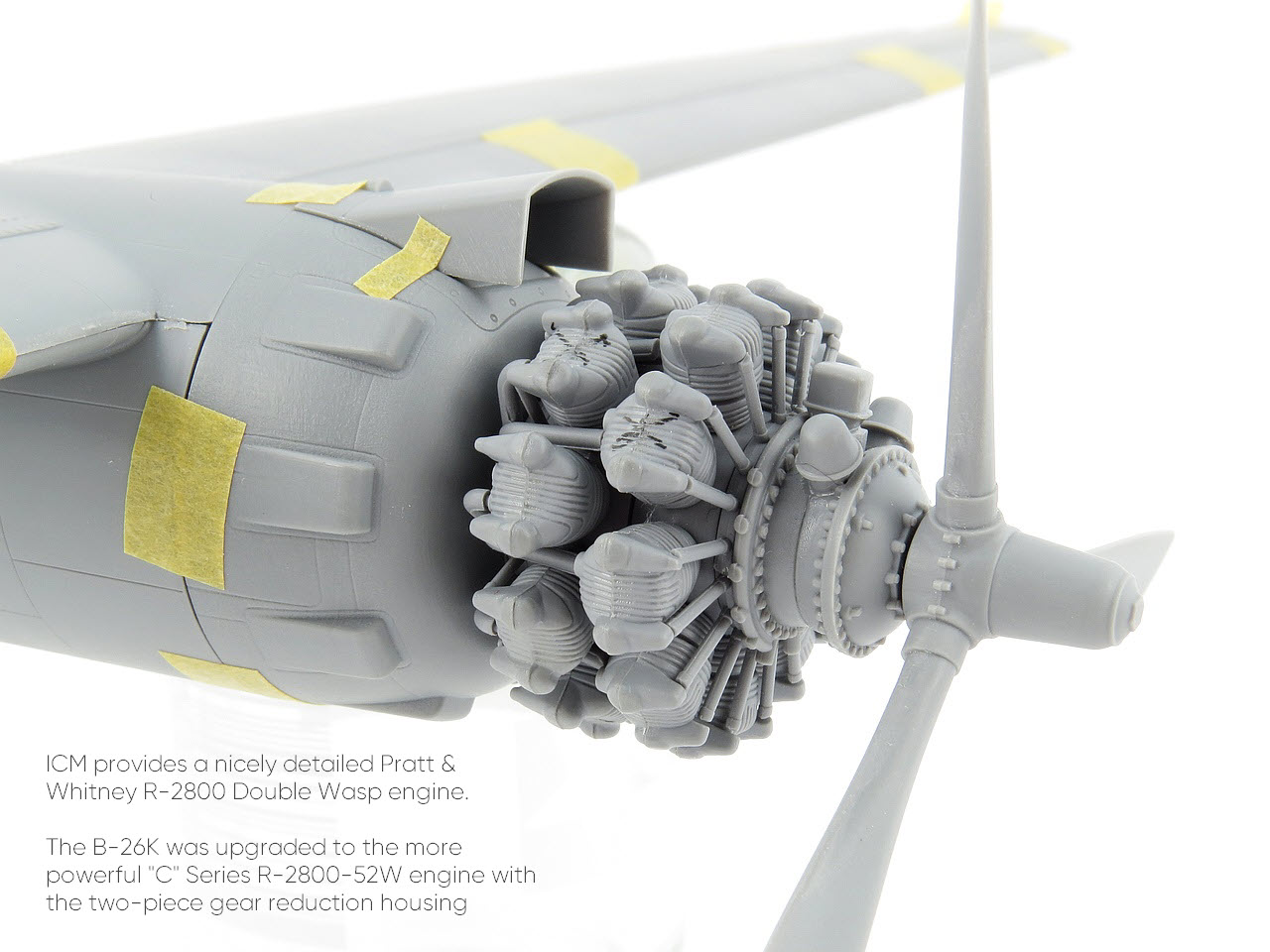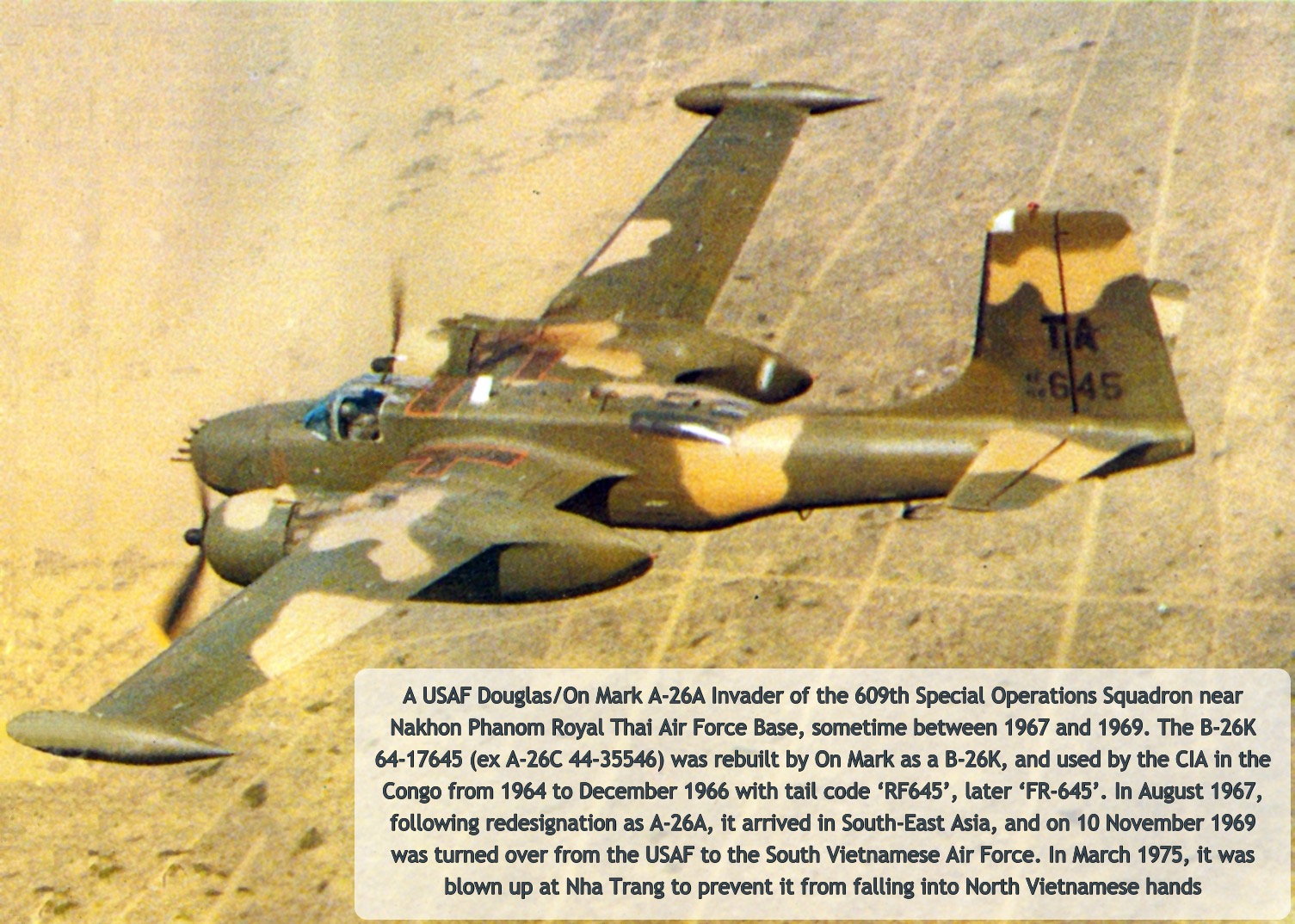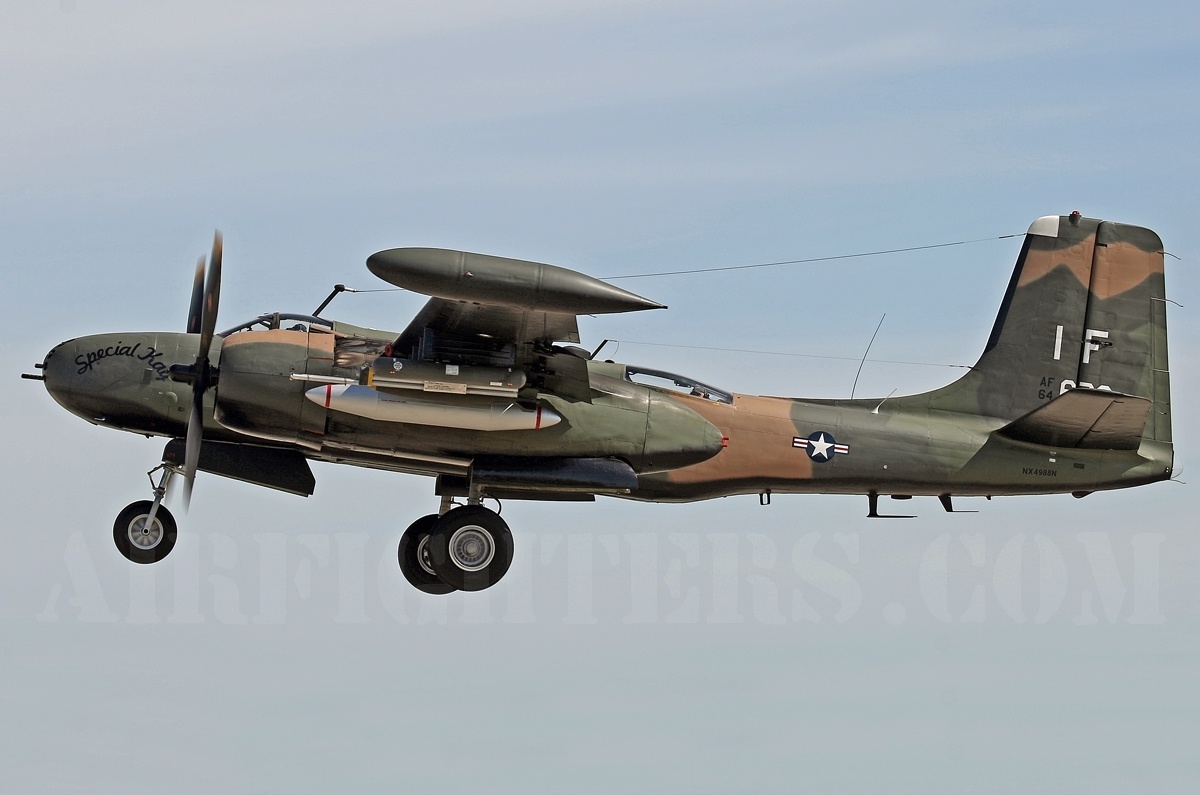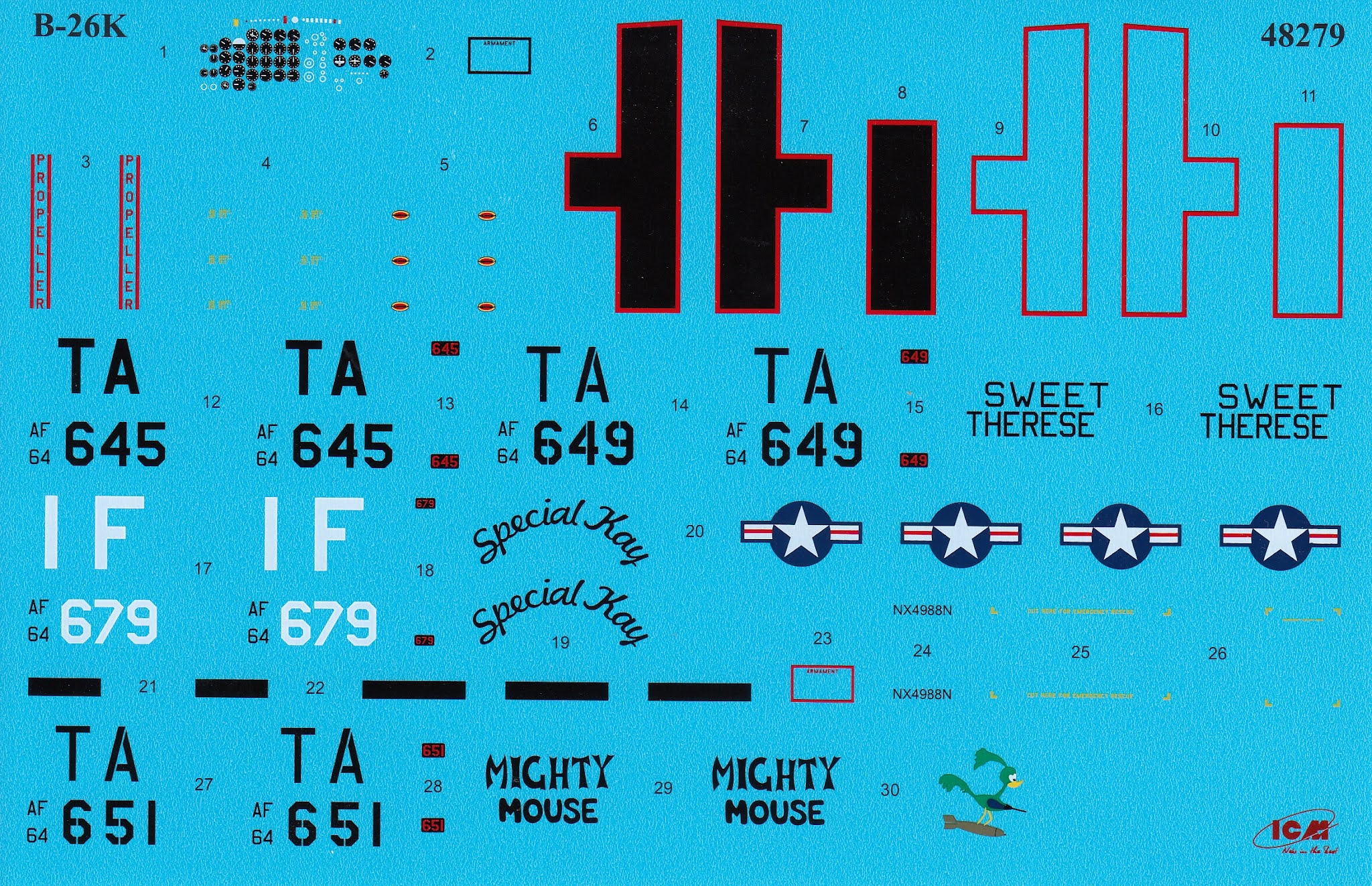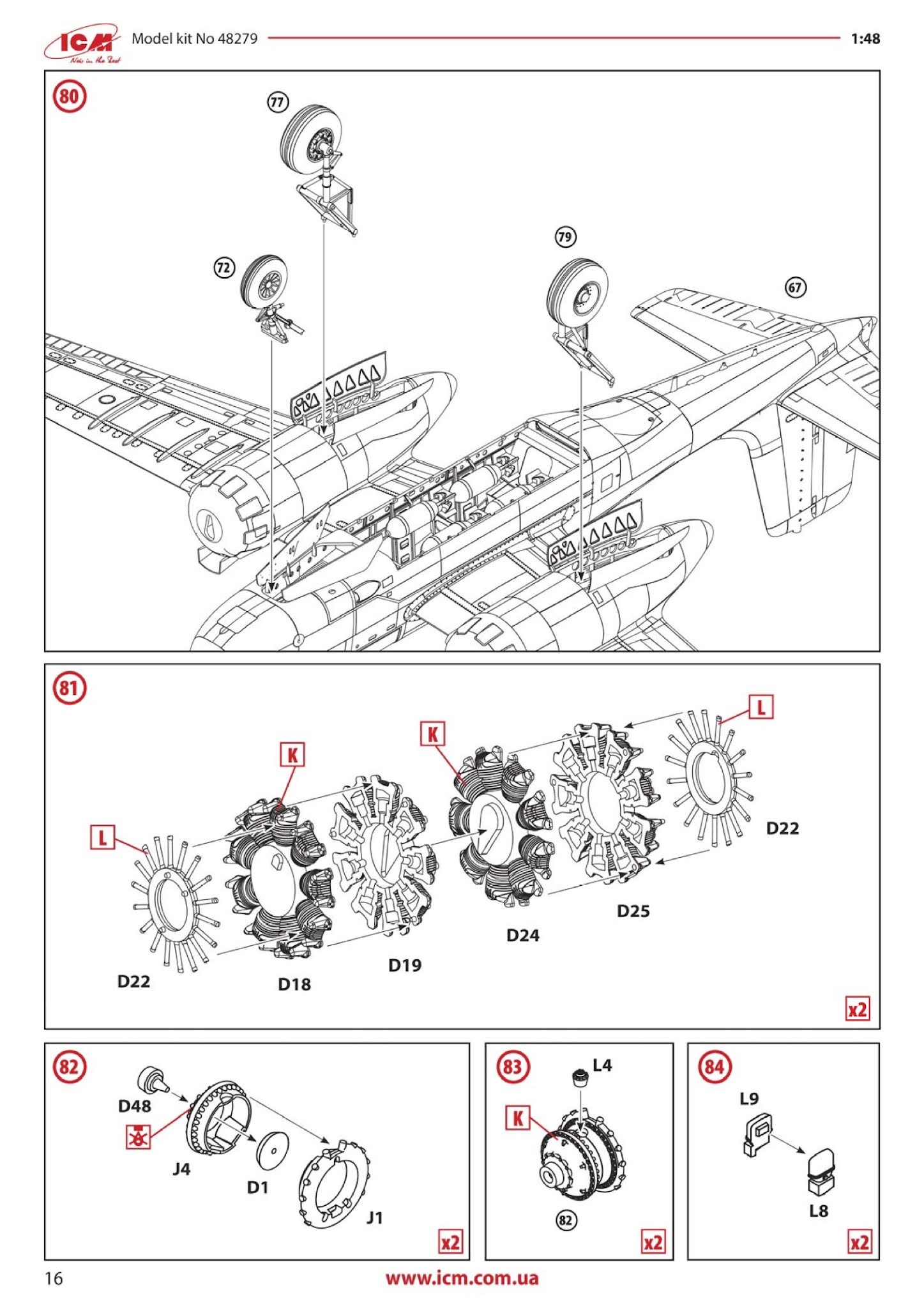Having reviewed most of ICM's 48th scale Invaders, we thought it only fair to let Gary Wickham look at their latest, most anticipated B-26K Counter Invader kit. Not only that, but the accompanying paint set and weapons kit sold separately are also shown in his thorough, hands-on review...
From ICM
Kit No: 48279
1/48th scale
Model Size (Length X Width) 325 X 455 Mm
Number Of Parts 344
4 marking choices in the box
Price: $85 USD from Hobbylink Japan
The On Mark B-26K Counter Invader was the final chapter in the development of the Douglas A-26 Invader as a fighting machine.
In 1961, the United States Air Force recalled many WW2/Korean era Invaders back into service for use in clandestine operations in South Vietnam, where they were used as tactical bombers. While the B-26 aircraft were “officially” in service with the South Vietnamese Air Force, the Invaders were actually flown by American aircrews.
In 1961, the United States Air Force recalled many WW2/Korean era Invaders back into service for use in clandestine operations in South Vietnam, where they were used as tactical bombers. While the B-26 aircraft were “officially” in service with the South Vietnamese Air Force, the Invaders were actually flown by American aircrews.
Work on a modernised Invader began in 1962, but was given more urgency after a series of wing failures in 1963 and early 1964 forced the Air Force to ground its fleet of elderly B-26s.
To fulfil their new counter-insurgency role, the US Air Force selected the On Mark Engineering Company of Van Nuys, California to extensively upgrade the Invader. In total, On Mark received forty (40) airframes of which only 30 were actually modified using the new 64-xxxxx numbers, the remaining 10 being kept for spares. Most Invaders picked for makeovers came from the boneyard at Davis-Monthan Air Force Base in Tucson, Arizona, where 300-some Invaders were parked in the ready-for-ingots section. The new designation: B-26K.
These aircraft were deployed to Southeast Asia and attached to the 609th Special Operations Squadron and were based in Phanom Air Base in Thailand. As Thailand didn’t permit the basing of bombers on its territory, in May 1966 the aircraft were reassigned the old attack designation of A26A, which brought the Invader full circle.
When the Counter Invader debuted in Southeast Asia it became known for its permanent call sign: “Nimrod,” a Biblical reference to Noah’s great-grandson, “a mighty hunter.” Thereafter fliers in the unit were called by the same nickname: The Nimrods.
Even in the fast company of F-4s and F-105s, as well as many other types that attacked traffic on the Ho Chi Minh Trail, the A-26 became known as “the best truck killer in Southeast Asia.” It had just the right combination of firepower, loitering time, and ruggedness.In addition, to being deployed against the Ho Chi Minh trail, the B-26K/A-26A Counter Invaders were flown over the panhandle of Laos, an area along the North Vietnamese border known as the Steel Tiger, in operations that were highly “black” and as a result the US national insignia were painted over to maintain “plausible deniability” should the aircraft be forced down.
The CIA also contracted pilots, some employed during the Bay of Pigs Invasion, to fly B-26Ks for ground attack against Simba rebels in the Congo Crisis. Newly re-manufactured B-26K Counter-Invaders were delivered to the Congo via Hurlburt Field in 1964.
The push for an all-jet air force is what some Air Commandos believe brought an end to their missions in November 1969 and the retirement of the A-26. The warplane had seen service in three wars spread across three decades, never quite getting pushed out of the inventory because it always managed to find a niche, even while performing its work in the same low-tech, dive-bomb, shoot-’em-up way it had since World War II. This time, though, the aeroplane would stay retired for good.
KIT OVERVIEW - ICM 1:48 Douglas B-26K Counter Invader (48279)
This is the sixth (and perhaps final) boxing of the new tooled 1:48 Invader family from ICM. Why the final? Well, they have now delivered boxings of all the major A/B-26B/C/K Invaders variants. I'm so happy they made the effort to give us a dedicated B-26K kit because until now the only options in 1:48 were resin conversion sets (some good, some bad) designed to used with the aging Monogram Invader.
The B-26K Counter Invader was a major redesign of the Invader. On Mark Engineers, of Van Nuys California, was chosen because it had developed some expertise in converted surplus B-26s into high-speed commercial transport aircraft. On Mark proposed an almost total rebuild of the aircraft including the following major modifications:
-Each wing was reinforced with steel straps running from tip to root, partly to solve the wing failure problem but more importantly to allow for the installation of eight hardpoints (four per wing) each capable of carrying 1,000lb of stores, bringing the total payload of the B-26 up to 12,000lb.
-These eight (8) hardpoints allowed the B-26K to carry a wide range of armaments, including XM75 grenade launchers, P-2 grenade dispensers, LAU-3A, MA3, Aero 6A and LAU-10A rockets, MA3 rocket adaptors, SUU12 .50-caliber machine gun pods and bombs of up to 1,000lb. The inboard pylons could also carry a 230-gallon drop tank.
-Installation of improved R-2800-52W engines with water injection, producing 2,500 horsepower for take-off versus the previous 2,000 T/O hp of the regular Invader's Dash-79 engines.
-Broad paddle Hamilton-Standard reversible pitch propellers were fitted to provide enhanced shorter landing rolls. These were actually DC-6 blades with 10 inches cut off the tips!
-Upgraded anti-skid brakes were fitted as part of a package that utilised KC-135 brakes, wheels and tires.
-Permanent 165gal wingtip tanks were fitted to all On Mark B-26Ks
-Both turrets were deleted and panelled over
-Dual flight controls were fitted in the cockpit. The B-26K could be configured with an eight-gun nose or to a glass nose for reconnaissance. When the glass nose was in place, the second set of flight controls was removed to allow access to and from the nose.
-B-26Ks were given rudders slightly broader in chord than traditional B-26. To accommodate the larger rudder the rear fuselage was extended by 12".
-In order to increase the rudder control response, vortex generators were added to the right side (only!) of the tail fin.
-A full package of up-to-date airborne electronics was installed and externally this resulted in an array of antenna configurations on the upper fuselage and underside of the rear fuselage.
-To solve an engine overheating problem first encountered by the CIA operated Invaders in the Congo, where the original intakes in the front of the engine cowling proved insufficient for the hot and humid conditions, the local crews hand-built new larger intakes at the rear of the cowling and installed these on all their deployed B-26Ks. The USAF later officially copied this field modification on all its other B-26Ks and it became known as "The Congo Mod."
-A pallet was devised to carry the F-492 reconnaissance camera system in the bomb bay of the RB-26K with camera windows in the bomb bay doors, covered by plates when not in use. Self-defence countermeasure flares were also fitted to the rear of the bombay doors.
So, as you can see there is a lot going on with a B-26K when compared to the original Invaders. In kit form, to do this properly ICM would need to give us whole new wings, new fuselage, new wheels/tires, pylons, wingtips tanks, new props, new dual-cockpit etc etc. That's a lot of changes and plenty of new toolings needed. So, just how well has ICM done in converting its original kit to a B-26K? Let's have a look.
The stars of this show are the new sprues H, J, K and L. These contain all the new B-26K specific parts we will need to build our Counter Invader. Four sprues of pure Nimrod happiness. By my count, ICM has delivered pretty much everything we need to be able to build an accurate B-26K out-of-the-box, and that is very welcome news. The remaining five sprues (A,B,C,D and E) contain the common parts (such as engines, undercarriage etc) used in previous kits.
ICM's 48th scale US Aviation Armament set (48406)
Of course, a Counter-Invader looks pretty bare without any weapons on those hardpoints and ICM has us covered on this front as well. Included in the box is a full set of their US Aviation Armament set (48406) which I suspect they created for the B-26K kit and then released it on its own as well.
The set includes two each of the following munitions:
BLU-23 - 500-pound firebomb (napalm)
BLU-27 - 750-pound firebomb (napalm)
LAU-10A - ZUNI Rocket Launcher
LAU-68 - 7 Tube 70 mm (2.75”) rocket launcher
LAU-69A - 19-Tube 70 mm (2.75”) rocket launcher
Mk77 - 750-pound (340 kg) air-dropped incendiary bomb
Mk24 - Parachute flare (2 Million candlepower) night observation
Mk81 - 250-pound (110 kg) general-purpose bomb
Mk81 Snakeye - with a TRD (Tail Retarding Device) to increase the bomb's drag after release
SUU-14/A - Submunition Dispenser
Mk82 - 500 lb (227 kg) general-purpose bomb
Mk82 Snakeye - fitted with a TRD (Tail Retarding Device) to increase the bomb's drag after release
MER - multiple ejector rack, weapon suspension unit
The set includes two each of the following munitions:
BLU-23 - 500-pound firebomb (napalm)
BLU-27 - 750-pound firebomb (napalm)
LAU-10A - ZUNI Rocket Launcher
LAU-68 - 7 Tube 70 mm (2.75”) rocket launcher
LAU-69A - 19-Tube 70 mm (2.75”) rocket launcher
Mk77 - 750-pound (340 kg) air-dropped incendiary bomb
Mk24 - Parachute flare (2 Million candlepower) night observation
Mk81 - 250-pound (110 kg) general-purpose bomb
Mk81 Snakeye - with a TRD (Tail Retarding Device) to increase the bomb's drag after release
SUU-14/A - Submunition Dispenser
Mk82 - 500 lb (227 kg) general-purpose bomb
Mk82 Snakeye - fitted with a TRD (Tail Retarding Device) to increase the bomb's drag after release
MER - multiple ejector rack, weapon suspension unit
HANDS-ON - ICM 1:48 Douglas B-26K Counter Invader (48279)
As I have previously completed an in-depth review of the base ICM Invader kit(s), my intention for this B-26K review is to focus purely on the new Counter-Invader specific parts that ICM have tooled for this latest kit. I feel that that the base (original) Invader kit from ICM is a very solid tooling and hope that with this new B-26K kit that they have taken the time/effort to develop all the specific mods to the original kit so that their B-26K looks every bit like the conversion job that On Mark did to the real Invader.
As I have previously completed an in-depth review of the base ICM Invader kit(s), my intention for this B-26K review is to focus purely on the new Counter-Invader specific parts that ICM have tooled for this latest kit. I feel that that the base (original) Invader kit from ICM is a very solid tooling and hope that with this new B-26K kit that they have taken the time/effort to develop all the specific mods to the original kit so that their B-26K looks every bit like the conversion job that On Mark did to the real Invader.
Let's find out!
Starting in the cockpit, On Mark upgraded the standard Invader by adding a second seat, flight instruments and control yoke, which allowed flight from either seat. As the B-26K could be configured with an eight-gun nose or to a glass nose for reconnaissance, the second set of flight controls was removable to allow access to and from the nose when the glass nose was in place.
ICM has provided a completely new cockpit for this boxing. All the parts from the floor up are new, including the centre console. Decals are provided for the instrument panel and I am sure that in time the aftermarket companies such as Eduard will release detail sets to match.
ICM has provided a completely new cockpit for this boxing. All the parts from the floor up are new, including the centre console. Decals are provided for the instrument panel and I am sure that in time the aftermarket companies such as Eduard will release detail sets to match.
The handles on the control yokes provided by ICM are not an exact match for those fitted by On Mark, but it's an easy fix to re-shape by cutting off the upper strut which gets it much closer.
New 165 gallon tip tanks fitted to the B-26K by On Mark as part of the upgrade/conversion. These were designed to be permanent and not removable like underwing drop tanks. The normal wingtip navigation lights were carried on the sides of the tanks instead.
The new ICM parts for the tip tanks seem to be a good match in terms of size and shape. Some of the surface detailing, such as the two filler caps, have been omitted by ICM and I'll be adding those to my build as they are quite visibly prominent. The fit of the tank to the wing is very neat and the use of alignment pins helps the modeller greatly.
With the removal of the two defensive turrets, the rear (gunners) compartment was converted for use by an observer who operated the camera equipment (when fitted). With the removal of the turret sighting mechanism, the compartment was relatively roomy. A new seat was installed on the port side directly in front of the camera control panel.
ICM has done a good job of reworking the bulkheads and side walls in the rear compartment to accurately represent the new camera observation bay as fitted to RB-26K's.
New 165 gallon tip tanks fitted to the B-26K by On Mark as part of the upgrade/conversion. These were designed to be permanent and not removable like underwing drop tanks. The normal wingtip navigation lights were carried on the sides of the tanks instead.
The new ICM parts for the tip tanks seem to be a good match in terms of size and shape. Some of the surface detailing, such as the two filler caps, have been omitted by ICM and I'll be adding those to my build as they are quite visibly prominent. The fit of the tank to the wing is very neat and the use of alignment pins helps the modeller greatly.
With the removal of the two defensive turrets, the rear (gunners) compartment was converted for use by an observer who operated the camera equipment (when fitted). With the removal of the turret sighting mechanism, the compartment was relatively roomy. A new seat was installed on the port side directly in front of the camera control panel.
ICM has done a good job of reworking the bulkheads and side walls in the rear compartment to accurately represent the new camera observation bay as fitted to RB-26K's.
They have incorrectly placed the seat in the middle but that is an easy fix to move it to the left. The only thing that could be added (if you feel like it) is some cabling and seat belts to busy up the space.All B-26K airframes were fitted with rudders that were slightly broader in chord than traditional B-26. The new larger rudders were no longer fabric covered but metal instead. To accommodate the larger rudder the rear fuselage end was extended by 12 inches. At the same, in order to increase the rudder control response, vortex generators were added to the right side (only!) of the tail fin.
The new fuselage halves (H1 & H15) provided by ICM in this kit have been upgraded with the new B-26K specific vertical tail. The vortex generators are moulded onto the right side tail and the fuselage lengthened to fit the new rudder. A navigation strobe light was also fitted to the very top of the vertical tail on the B-26K.
A side by side comparison of the ICM parts for the early (fabric) and On Mark (metal) rudders shows that the B-26K part is 4mm wider in 1:48. When scaled up to 1/1 this represents 7.5 inches. I don't have the actual measurement of the real rudder but we do know that overall the fuselage was extended by a total of 12 inches, so the rudder being 7.5 inches seems credible.
The On-Mark Counter Invader featured strengthened wings. To ensure wing integrity, the new skin was applied to the upper and lower surfaces of the wings between the spars; new forward and rear spar webs were installed, and steel straps were added to the spar caps.
ICM has tooled completely new wings (top and bottom) for this B-26K kit. This would certainly have been the best solution as they needed to accommodate the steel strap reinforcing, wingtip changes for the tanks and mounting points for the new underwing hardpoints. I was quite relieved when I found these new wings in the box as it indicated to me that ICM had taken this conversion seriously and done it properly.
A major incentive for the new reinforced wings was to allow for the installation of eight hardpoints (four per wing), each capable of carrying 1,000lb of stores, bringing the total payload of the B-26 up to 12,000lb.
These eight (8) hardpoints allowed the B-26K to carry a wide range of armaments, including XM75 grenade launchers, P-2 grenade dispensers, LAU-3A, MA3, Aero 6A and LAU-10A rockets, MA3 rocket adaptors, SUU12 .50-caliber machine gun pods and bombs of up to 1,000lb. The inboard pylons could also carry a 230-gallon drop tank.
As with the other new parts, ICM has captured the shape and surface detailing on the pylons very well. To cater for the dihedral of the wing and the sit of the pylons, ICM has moulded elliptical mounting recesses on the surface of the lower wing into which the hardpoints fit. Be sure to pay attention to the assembly sequence and apply the correct pylon parts to each wing as they are different and will not sit right if you accidentally swap them between wings.
To help provide shorter landing rolls, often needed on improvised landing strips in Vietnam, the B-26K was fitted with upgraded anti-skid brakes. These were part of a package that utilised KC-135 brakes, wheels and tires.
At first glance, I had some concerns about the accuracy of the ICM main wheels. As I had in my stash a B-26K conversion by Cutting Edge (for the old Monogram kit), I grabbed the resin wheels and sat them next to the ICM plastic items. This really highlighted for me the following issues:
-The ICM tyres seem to be too large, which makes the whole wheel too big (high) overall. The hubs seem to be accurate but the tyre sidewalls are overly large.
-The shape of the tires also looks wrong. The sidewalls and top are squared when compared to the rounded shape of the real tire.
-The ICM tyre has no tread pattern at all. The real B-26K wheel (KC-135) incorporated a typical radial tread pattern.
These three issues are enough to convince me to leave the ICM main wheels in the box and find (or wait for) aftermarket options.
The nose wheel on the B-26K was largely unchanged from earlier Invaders, with the most visible difference being the new tyre with a radial tread pattern.
The ICM nosewheel, apart from the lack of radial tread, is a much better match to both the Cutting Edge resin part and of course the real aircraft. I find it a bit odd that ICM went to the trouble of tooling new wheels for the B-26K kit and made no effort to replicate the tread pattern.
To solve an engine overheating problem first encountered by the CIA operated Invaders in the Congo, where the original intakes in the front of the engine cowling proved insufficient for the hot and humid conditions, the local crews hand-built new larger intake openings at the rear of the cowling and installed these on all their deployed B-26Ks. The USAF later officially copied this very successful field modification on all its B-26Ks for use in South East Asia and this became known as "The Congo Mod."
ICM has tooled up new engine cowlings (J10) which have the front intake removed and the distinctive strakes blended into the rear of the cowls. The original cowlings are also included in the box (on one of the original sprues) which allows modellers to build their B-26K with the original intake (before being modded). The new cowlings have a nasty mold seam line that is easy enough to remove with a sanding stick. You will also want to fill in the noticeable circumferential sink mark that runs around the front lip of the cowling. I used Tamiya Basic plastic putty as I find this sands and blends nicely in such situations.
In addition to being moved to the back of the cowling, the "Congo Mod" intake was larger than the early intake and could funnel more cooling air in. A butterfly valve was fitted horizontally inside the intake and could be made to open or close by the aircrew depending on the need for air.
Part K5 provides a new drop-in centre fuselage skin which ICM has fitted with mounting holes for the assorted antennae. The part is a neat fit and the join lines fall on natural panel lines.
It was envisaged by the USAF that the new B-26K could be also be used in a tactical reconnaissance role. To this end, a pallet was devised to carry the F-492 reconnaissance camera system in the bomb bay of the RB-26K with camera windows cut into the bomb bay doors, covered by plates when not in use. Self-defence countermeasure flares were also fitted to the rear of the bombay doors.
Despite giving us all the camera control equipment in the rear compartment and the cover plates in the bomb bay doors, ICM has not included any of the camera equipment itself. I don't really hold this against them as the RB-26K's were never used in Vietnam and were fitted with the glass nose (which this kit does not include). Perhaps ICM plan to do one more boxing for the RB-26K in which we will get the glass nose, camera pallet and doors with the cutouts opened. Fingers crossed.
As with the upper turret, the lower turret was also deleted and faired over. A drop-in blanking plate (H4) is provided to make this conversion super simple.
On Mark took the opportunity to install in the B-26K, the improved R-2800-52W "C" series engines which incorporated water injection. The new engines produced 2,500 horsepower for take-off versus the previous 2,100 T/O hp of the earlier "B" series R-2800-79 Invader's engines.
The later "C" series P&W R-2800 engines incorporated a new two-piece gear reduction housing fitted to the front of the motor. This is a detail that many model manufacturers would have overlooked or simply not bothered with and so I feel it's to ICM's great credit that they tooled up new parts for their B-26K kit. It shows a level of attention to detail that I appreciate.
A dry fit of the full "Double Wasp" R-2800 and propellor gives us a chance to appreciate the level of detail ICM have put into these 1:48 parts. Of course, if you install the cowlings you won't see any of this detail but as modellers, we seem to like that it's there.
The B-26K was fitted with broad paddle Hamilton-Standard reversible pitch propellers to provide enhanced shorter landing rolls. These were actually DC-6 blades with 10 inches cut off the tips.
Accurately designing aircraft propellers seems to be a major Achilles heel for many kit manufacturers. Even a small mis-shape throws out the whole look of the finished model. To my eye, the ICM props are not perfect (perhaps a little too symmetric) but I'd be quite happy to use them on my model. It will be interesting to see if Quickboost or Aires bother to give us some resin options in the future.
COLORS & MARKINGS - ICM 1:48 Douglas B-26K Counter Invader (48279)
ICM has chosen to provide four (4) SEA (South East Asia) three tone camo over black marking options in this kit. Perhaps they are planning a second boxing to give us some of the Cuban and other foreign schemes.
I did a quick airbrush test, on one of the spare wings, with my Iwata Eclipse 0.35mm. I thinned with Meng's (AK) Acrylic thinner at a ratio of roughly 60% thinner. I'm not a big fan of pure acrylic paints such as these (as I normally use lacquers for aircraft) but I found it sprayed well enough and the colours seem to look pretty accurate.
The new fuselage halves (H1 & H15) provided by ICM in this kit have been upgraded with the new B-26K specific vertical tail. The vortex generators are moulded onto the right side tail and the fuselage lengthened to fit the new rudder. A navigation strobe light was also fitted to the very top of the vertical tail on the B-26K.
A side by side comparison of the ICM parts for the early (fabric) and On Mark (metal) rudders shows that the B-26K part is 4mm wider in 1:48. When scaled up to 1/1 this represents 7.5 inches. I don't have the actual measurement of the real rudder but we do know that overall the fuselage was extended by a total of 12 inches, so the rudder being 7.5 inches seems credible.
The On-Mark Counter Invader featured strengthened wings. To ensure wing integrity, the new skin was applied to the upper and lower surfaces of the wings between the spars; new forward and rear spar webs were installed, and steel straps were added to the spar caps.
ICM has tooled completely new wings (top and bottom) for this B-26K kit. This would certainly have been the best solution as they needed to accommodate the steel strap reinforcing, wingtip changes for the tanks and mounting points for the new underwing hardpoints. I was quite relieved when I found these new wings in the box as it indicated to me that ICM had taken this conversion seriously and done it properly.
A major incentive for the new reinforced wings was to allow for the installation of eight hardpoints (four per wing), each capable of carrying 1,000lb of stores, bringing the total payload of the B-26 up to 12,000lb.
These eight (8) hardpoints allowed the B-26K to carry a wide range of armaments, including XM75 grenade launchers, P-2 grenade dispensers, LAU-3A, MA3, Aero 6A and LAU-10A rockets, MA3 rocket adaptors, SUU12 .50-caliber machine gun pods and bombs of up to 1,000lb. The inboard pylons could also carry a 230-gallon drop tank.
As with the other new parts, ICM has captured the shape and surface detailing on the pylons very well. To cater for the dihedral of the wing and the sit of the pylons, ICM has moulded elliptical mounting recesses on the surface of the lower wing into which the hardpoints fit. Be sure to pay attention to the assembly sequence and apply the correct pylon parts to each wing as they are different and will not sit right if you accidentally swap them between wings.
To help provide shorter landing rolls, often needed on improvised landing strips in Vietnam, the B-26K was fitted with upgraded anti-skid brakes. These were part of a package that utilised KC-135 brakes, wheels and tires.
At first glance, I had some concerns about the accuracy of the ICM main wheels. As I had in my stash a B-26K conversion by Cutting Edge (for the old Monogram kit), I grabbed the resin wheels and sat them next to the ICM plastic items. This really highlighted for me the following issues:
-The ICM tyres seem to be too large, which makes the whole wheel too big (high) overall. The hubs seem to be accurate but the tyre sidewalls are overly large.
-The shape of the tires also looks wrong. The sidewalls and top are squared when compared to the rounded shape of the real tire.
-The ICM tyre has no tread pattern at all. The real B-26K wheel (KC-135) incorporated a typical radial tread pattern.
These three issues are enough to convince me to leave the ICM main wheels in the box and find (or wait for) aftermarket options.
The nose wheel on the B-26K was largely unchanged from earlier Invaders, with the most visible difference being the new tyre with a radial tread pattern.
The ICM nosewheel, apart from the lack of radial tread, is a much better match to both the Cutting Edge resin part and of course the real aircraft. I find it a bit odd that ICM went to the trouble of tooling new wheels for the B-26K kit and made no effort to replicate the tread pattern.
To solve an engine overheating problem first encountered by the CIA operated Invaders in the Congo, where the original intakes in the front of the engine cowling proved insufficient for the hot and humid conditions, the local crews hand-built new larger intake openings at the rear of the cowling and installed these on all their deployed B-26Ks. The USAF later officially copied this very successful field modification on all its B-26Ks for use in South East Asia and this became known as "The Congo Mod."
ICM has tooled up new engine cowlings (J10) which have the front intake removed and the distinctive strakes blended into the rear of the cowls. The original cowlings are also included in the box (on one of the original sprues) which allows modellers to build their B-26K with the original intake (before being modded). The new cowlings have a nasty mold seam line that is easy enough to remove with a sanding stick. You will also want to fill in the noticeable circumferential sink mark that runs around the front lip of the cowling. I used Tamiya Basic plastic putty as I find this sands and blends nicely in such situations.
In addition to being moved to the back of the cowling, the "Congo Mod" intake was larger than the early intake and could funnel more cooling air in. A butterfly valve was fitted horizontally inside the intake and could be made to open or close by the aircrew depending on the need for air.
To see how well ICM had captured the overall shape of the new intake I fitted all the engine, cowlings and flaps together temporarily with tape. The end result looks very convincing and I'm pleased that ICM got this right. The only thing they left out was the butterfly valve which will be an easy task to fabricate from sheet styrene.
A final view of the new cowlings showing the sanding and filling work I undertook.
Due to the change in the role of the counter-invader from tactical bomber to counter-insurgency night intruder, the need for defensive turrets was eliminated. As a result, both upper and lower turrets were deleted and skinned over. A full package of up-to-date airborne electronics was installed and externally this resulted in an array of antenna configurations on the upper fuselage.Part K5 provides a new drop-in centre fuselage skin which ICM has fitted with mounting holes for the assorted antennae. The part is a neat fit and the join lines fall on natural panel lines.
It was envisaged by the USAF that the new B-26K could be also be used in a tactical reconnaissance role. To this end, a pallet was devised to carry the F-492 reconnaissance camera system in the bomb bay of the RB-26K with camera windows cut into the bomb bay doors, covered by plates when not in use. Self-defence countermeasure flares were also fitted to the rear of the bombay doors.
Despite giving us all the camera control equipment in the rear compartment and the cover plates in the bomb bay doors, ICM has not included any of the camera equipment itself. I don't really hold this against them as the RB-26K's were never used in Vietnam and were fitted with the glass nose (which this kit does not include). Perhaps ICM plan to do one more boxing for the RB-26K in which we will get the glass nose, camera pallet and doors with the cutouts opened. Fingers crossed.
As with the upper turret, the lower turret was also deleted and faired over. A drop-in blanking plate (H4) is provided to make this conversion super simple.
On Mark took the opportunity to install in the B-26K, the improved R-2800-52W "C" series engines which incorporated water injection. The new engines produced 2,500 horsepower for take-off versus the previous 2,100 T/O hp of the earlier "B" series R-2800-79 Invader's engines.
The later "C" series P&W R-2800 engines incorporated a new two-piece gear reduction housing fitted to the front of the motor. This is a detail that many model manufacturers would have overlooked or simply not bothered with and so I feel it's to ICM's great credit that they tooled up new parts for their B-26K kit. It shows a level of attention to detail that I appreciate.
A dry fit of the full "Double Wasp" R-2800 and propellor gives us a chance to appreciate the level of detail ICM have put into these 1:48 parts. Of course, if you install the cowlings you won't see any of this detail but as modellers, we seem to like that it's there.
The B-26K was fitted with broad paddle Hamilton-Standard reversible pitch propellers to provide enhanced shorter landing rolls. These were actually DC-6 blades with 10 inches cut off the tips.
Accurately designing aircraft propellers seems to be a major Achilles heel for many kit manufacturers. Even a small mis-shape throws out the whole look of the finished model. To my eye, the ICM props are not perfect (perhaps a little too symmetric) but I'd be quite happy to use them on my model. It will be interesting to see if Quickboost or Aires bother to give us some resin options in the future.
COLORS & MARKINGS - ICM 1:48 Douglas B-26K Counter Invader (48279)
ICM has chosen to provide four (4) SEA (South East Asia) three tone camo over black marking options in this kit. Perhaps they are planning a second boxing to give us some of the Cuban and other foreign schemes.
B-26K (64-17651) "Mighty Mouse"
56th Air Commando Wing, Nakhon Phanom AB, 1967, Arrived at Davis-Monthan AFB, 1970
Subsequently preserved at Seoul Museum, Korea then Korean Aerospace Industry Aerospace Museum, Sacheon AFB
B-26K (64-17649) "Sweet Therese"
Deployed to the Congo for CIA operation Anstalt Wigmo, 1965
Assigned to 56th Air Commando Wing, Nakhon Phanom AB, 1967, Arrived at Davis-Monthan AFB, 1970. Declared excess by USAF 1972
B-26K (64-17645) "Magnet Ass"
Deployed to the Congo for CIA operation Anstalt Wigmo, 1964
Assigned to 56th Air Commando Wing, Nakhon Phanom AB, 1967, Transferred to Sth Vietnamese AF, 1969. Blown up at Nha Trang to prevent enemy capture, 1975
B-26K (64-17679) "Special Kay"
1st Air Commando Wing at Hurlburt Field, 1966
1st Air Commando Wing at England AFB, 1968
Arrived at Davis-Monthan AFB, 1969
Sold to State of Georgia Forestry Commission as N269G. Stored in open storage in Macon, GA, 1971
Moved to Ft. Worth, Meacham Field to undergo restoration at Greatest Generation Aircraft, 2013
Currently operated by the Vintage Flying Museum in Ft. Worth, TX
The decals are self-printed by ICM and look to be in good register. The various styles of walkways are included along with the very limited stencilling for the aircraft. The weapon sheet contains stencils suitable for the various provided munitions.
ICM's "Invader" acrylic paint set (#3007)
ICM has also released an "Invader" acrylic paint set (#3007) designed for the B-26K Invader kit. The paint is water-based acrylic and comes in 12 ml bottles ready for use with a brush. To airbrush, you must dilute with water or acrylic thinners 40-60%. ICM recommends that when airbrushing that you first apply a primer to the plastic.I did a quick airbrush test, on one of the spare wings, with my Iwata Eclipse 0.35mm. I thinned with Meng's (AK) Acrylic thinner at a ratio of roughly 60% thinner. I'm not a big fan of pure acrylic paints such as these (as I normally use lacquers for aircraft) but I found it sprayed well enough and the colours seem to look pretty accurate.
In the set, you are provided with the five (5) major colours needed to finish the B-26K in a SEA scheme. US Dark Green, Tan Earth, Extra Dark Green, Black, Silver and Satin Varnish.
CONCLUSION - ICM 1:48 Douglas B-26K Counter Invader (48279)
I'm very pleased with the job that ICM has done in converting their base Invader kit into a B-26K. Overall I'd give this kit a 9/10 score because they have done their homework and made the effort to tool up all the specific parts that make a normal invader into a B-26K.
There is still scope for modellers to add more detail in the cockpit, engines and surface should they desire, but what you have in the box is an excellent 1:48 Counter-Invader. I'm also very impressed with the range of weapons included in the box. ICM has not cut corners or taken any lazy shortcuts in this boxing.
I'm very pleased with the job that ICM has done in converting their base Invader kit into a B-26K. Overall I'd give this kit a 9/10 score because they have done their homework and made the effort to tool up all the specific parts that make a normal invader into a B-26K.
There is still scope for modellers to add more detail in the cockpit, engines and surface should they desire, but what you have in the box is an excellent 1:48 Counter-Invader. I'm also very impressed with the range of weapons included in the box. ICM has not cut corners or taken any lazy shortcuts in this boxing.
Very well done ICM.
As with the previous ICM Invader boxings I have no hesitation at all in recommending this kit.
ASSEMBLY INSTRUCTIONS - ICM 1:48 Douglas B-26K Counter Invader (4827
As with the previous ICM Invader boxings I have no hesitation at all in recommending this kit.
Gary Wickham
Many thanks to ICM plastic model kits for supplying the kit for Gary to review.
You can see more of Gary's Work on his ScaleSpot.com Website & his Facebook page.






















